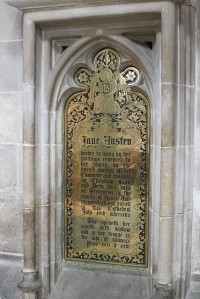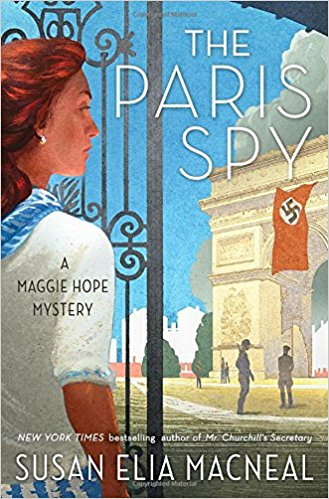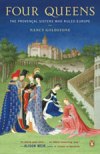 In 1820, three years after her death, Jane Austen’s publisher remaindered all copies of her books. She sunk into obscurity “out of print, out of demand, and almost out of mind.” Today, of course, Austen is a worldwide phenomenon.
In 1820, three years after her death, Jane Austen’s publisher remaindered all copies of her books. She sunk into obscurity “out of print, out of demand, and almost out of mind.” Today, of course, Austen is a worldwide phenomenon.
Claire Harman offers an engrossing account of the erratic and somewhat inexorable rise of Austen’s popularity in Jane’s Fame: How Jane Austen Conquered the World. Harman flavors her narrative with diverting bits of trivia, for example Rudyard Kipling was a fervent Janeite! He considered Austen’s gravesite at Winchester Cathedral to be the second holiest place in England after Shakespeare’s hometown of Stratford.
Harman begins with a look at Jane the author. In particular, I was fascinated to learn that Austen devised a proto cut-and-paste approach to revision by pinning small paper cutouts with new wording over sections of a working draft.
Austen struggled, however, to get her works published. Ultimately she sold both Sense and Sensibility and Pride and Prejudice at somewhat bargain rates just to see them in print. The success of these books allowed her to get a better deal for Mansfield Park, which financially was her most successful work, earning her £30 a year. Emma, however, sold the most copies on its initial run.
Tragically, it was just as Austen was gaining success and recognition—albeit anonymously as her works were published by “a Lady”—that she died. Her tombstone made no mention of her as an author.

An 1816 first edition of Emma.
During the nearly 13 years her books were out of print, copies were treasured and traded by a niche of faithful readers, including several luminaries of the literary world. Sir Walter Scott had the full set and read Pride and Prejudice at least three times. Other admirers included Robert Southey, Maria Edgeworth, Benjamin Disreali, Lord Tennyson, and Samuel Taylor Coleridge—but not William Wordsworth because, according to Coleridge’s daughter, he had no sense of humor.
Both English and pirated translations of Austen’s novels were read in France, Russia, Sweden, Switzerland, and even in America. I was gobsmacked to learn that James Fenimore Cooper’s first novel was actually a reworking of Persuasion titled Precaution, which flopped.
In 1833, Austen’s books were reissued as part of low-cost series, Standard Novels, sort of the Penguin Classics of the day. These editions began to sell steadily, gaining steam as the Victorian age took hold. Interest in Austen the author also grew steadily, erupting by the 1870s into the cult of the “Divine Jane.” Noted literary critic Leslie Stephen, father of Virginia Woolf, lampooned this as “Austenolatry”—a riff on “Bardolatry” the cult of Shakespeare. Not long after, another critic named George Saintsbury coined the term “Janeite,” still so popular today. At Winchester Cathedral, so many visitors turned up looking for Austen that her nephew and biographer James Edward Austen-Leigh erected a memorial plaque.

During World War I, Austen’s novels were a favorite among British soldiers and were well stocked in the trenches. They were also prescribed reading material to the wounded for their soothing and “salubrious” effects. By the 1920s, a “Janeite cabal” ran the Royal Society of Literature which would brook no criticism of the author. Beyond these hallowed halls, Austen had also exploded into the mainstream, via magazine articles, compilations, decorative special editions, and Austenalia: sequels and continuations of her novels. There was also a clamor for her letters, juvenilia, portraits, and any other related memorabilia, all of which were unearthed and published.
Jane had her share of detractors, though. Ralph Waldo Emerson had found her to be without genius or wit—a startling and somewhat paradoxical appraisal, but then he was rather severe. Surprisingly, Henry James felt she was overrated. Mark Twain’s derision of Austen has long been celebrated by her detractors, but what I didn’t know is that Twain repeatedly tried to read her works.
Still, Austen continued to gather fans: W.H. Auden, G.K. Chesterton, E.M. Forster, Katherine Mansfield, Rebecca West, and even the crotchety Winston Churchill. Another unlikely candidate, Aldous Huxley, wrote the screenplay for the first film adaption of Pride and Prejudice in 1940.

Memorial tablet honoring Jane Austen at Winchester Cathedral.
There are so many other delicious tidbits, as Harman takes us through different film adaptations and pop-culture trends to the current online zeitgeist of fansites and blogs. But I don’t want to give away the too much of the book, which I highly recommend. Throughout, Harman manages to keep Jane very much in the present with anecdotes, family memories, quotes, and a clever musings as to how Austen would react to all this. Indeed, we all wonder and that’s part of what drives our Janeite mania.
Even after reading her novels, her letters, various biographies, and, yes, many of the Austenalia takeoffs—we still thirst for more of Jane Austen.
As Harman quotes Katherine Mansfield:
“The truth is that every true admirer of the novels cherishes the happy thought that he alone—reading between the lines—has become the secret friend of their author.”
I read this book as part of the Austen in August annual reading event hosted by Roof Beam Reader. #AusteninAugustRBR
Worn Out With Civility at Mansfield Park
Jane Austen, Genius of Economic Game Theory?
How Did I Not Know About Marvel’s Pride & Prejudice?
Kate Middleton Decried as Jane Austen Character
When Pride and Prejudice Clicks, from Boring to Brilliant
Like Word Hits On Facebook
Follow @WordHits on Twitter
Read Full Post »
 I’m so excited to be partaking in the 5th Annual Austen in August extravaganza of all things Jane Austen! This summer marked the 200th anniversary of her too early death on July 18, 1817, and this is a wonderful way to honor and celebrate our beloved Jane.
I’m so excited to be partaking in the 5th Annual Austen in August extravaganza of all things Jane Austen! This summer marked the 200th anniversary of her too early death on July 18, 1817, and this is a wonderful way to honor and celebrate our beloved Jane.

 “It is, then, your opinion that Christmastime is an unlikely season for crime?” asks Hercule Poirot of Colonel Johnson, in Hercule Poirot’s Christmas (also published as Murder for Christmas and A Holiday for Murder).
“It is, then, your opinion that Christmastime is an unlikely season for crime?” asks Hercule Poirot of Colonel Johnson, in Hercule Poirot’s Christmas (also published as Murder for Christmas and A Holiday for Murder).
 “A Christmas Tragedy” is a short story in The Thirteen Problems collection, which was also published under the title The Tuesday Club Murders. I particularly like the setup, in which the different stories are told by a group of friends gathered together to discuss mysteries.
“A Christmas Tragedy” is a short story in The Thirteen Problems collection, which was also published under the title The Tuesday Club Murders. I particularly like the setup, in which the different stories are told by a group of friends gathered together to discuss mysteries. The narrative progresses with tension and a sense of impending doom. Some of the characters are shocked by the happenings and some seem to take a “positively ghoulish” delight in it all.
The narrative progresses with tension and a sense of impending doom. Some of the characters are shocked by the happenings and some seem to take a “positively ghoulish” delight in it all.






 In 1820, three years after her death, Jane Austen’s publisher remaindered all copies of her books. She sunk into obscurity “out of print, out of demand, and almost out of mind.” Today, of course, Austen is a worldwide phenomenon.
In 1820, three years after her death, Jane Austen’s publisher remaindered all copies of her books. She sunk into obscurity “out of print, out of demand, and almost out of mind.” Today, of course, Austen is a worldwide phenomenon.








